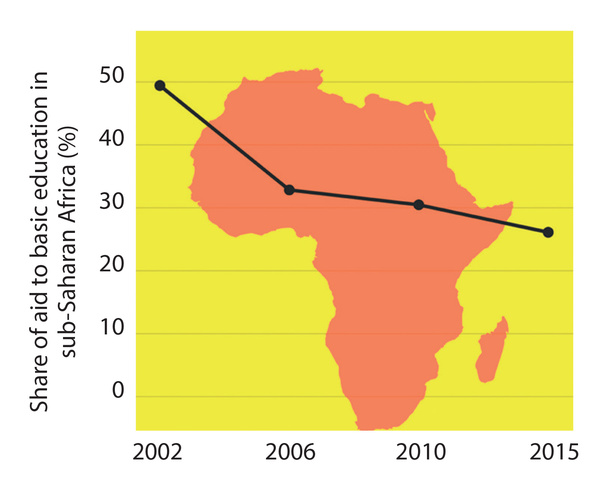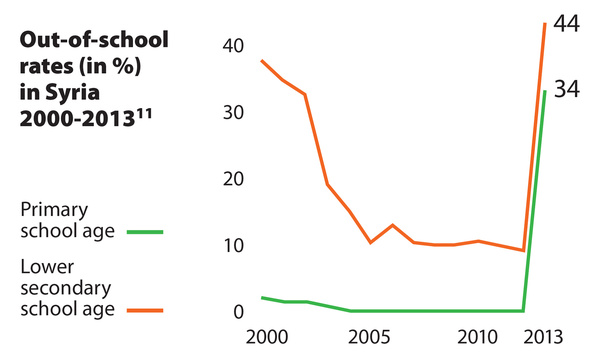Roll Call
The number of out-of-school children has dropped by 30% since 2000. But gains are uneven across the world – and stalled five years ago.

GOLD STAR Burundi2,3
$GDP per capita 736
Net enrolment:
- 2000 44%
- 2015 94%
Quantity not quality?
An increase in students has put a strain on resources.

Completion of secondary education 2008-145
- Low-income countries – 14%
- High-income countries – 84%
- 50% of youth (15-17 years) in South Asia and sub-Saharan Africa are out of school.5
Not just about where you live
Achievement varies by wealth and class within countries.
Pupil % scores in the 2009 international PISA maths tests, by economic, social and cultural status and gender4

Tertiary Education6
The total number of students going on to university or accessing vocational training has doubled since 2000. Women are closing the gap, but poor students, ethnic and indigenous minorities lag behind.
- 3x more women graduate than men in Caribbean countries, Northern Africa and Western Asia.
- 1% of indigenous students go on to receive a higher education in Mexico.
Lateness7
The ‘Sustainable Development Goal 4’ for Education aims for 12 years universal*, quality schooling by 2030. At this rate, we will hit the target 50 years late.

70% of children in low-income countries will complete primary school by 2030.
*universal = over 98% of countries worldwide
Girls in school
Progress towards achieving gender parity in enrolment, particularly in primary school, is hailed as a great success story. On average, roughly the same number of girls attended primary school as boys in 2014. But girls are less likely to move on to the next phase: fewer than 50% of countries were projected to reach gender parity in secondary school by 2015.8

GOLD STAR Afghanistan
Girls enrolled in primary school:
- 1999 4%
- 2012 87%
Footing the bill
Many governments are spending more on education. But few have prioritized learning in national budgets.
- 1% increase of GDP spend in 38 countries 1999-2012.2
Domestic spending dwarfs external assistance. But the total amounts fall short of what is needed to educate the world’s children.
Spending on education per primary-aged child in sub-Saharan African states, 20122
- International aid $12
- National budgets $136


Aid10
Donor spending on education is reducing as a percentage of total development aid.

Aid is not going where it is needed most.
Donors are giving a similar share of aid to basic education in sub-Saharan Africa, home to over 50 per cent of the world’s out-of-school primary-age children, as North Africa and West Asia, home to just 9 per cent.
At war
Around 25 million of the world’s out-of-school children are in conflict zones.12
Children who complete primary education13
- 58% Conflict zones
- 75% Conflict-free countries
Syria
Before the war in 2011, every child went to primary school. Now 2.8 million – in and outside the country – are missing out on education.14

- Global Education Monitoring (GEM) report, ‘Leaving no one behind’, July 2016 bit.ly/263million
- UNESCO, EFA Global Monitoring Report, 2015 nin.tl/EducationMDGs
- UNESCO nin.tl/UISBurundi
- UNESCO nin.tl/YouthSkills2012
- World Education Blog, October 2016 nin.tl/MonitoringProgress
- UNESCO, April 2017 nin.tl/TertiaryEducation
- GEM report, 2016 bit.ly/sdg4all
- UNESCO, Gender and EFA 2000 - 2015 bitly.com/efa gender
- Oxfam, ‘Ending the era of tax havens’, March 2016 nin.tl/OxfamTaxHavens
- GEM report Policy Paper 31, May 2017 bit.ly/FundEd
- GEM report nin.tl/AdolescentsOut
- UNICEF, April 2017 nin.tl/25millionConflict
- UN news, January 2016 nin.tl/SyriaLostGeneration
- UNESCO nin.tl/HumanitarianEduAid

